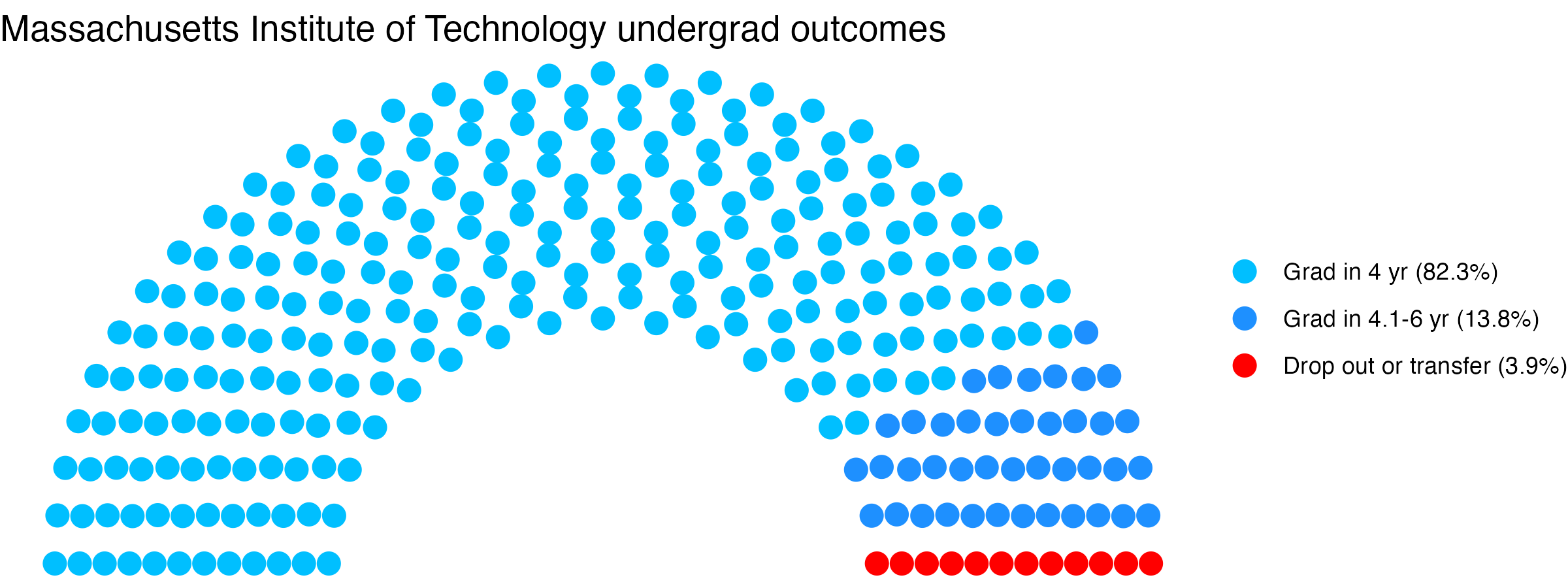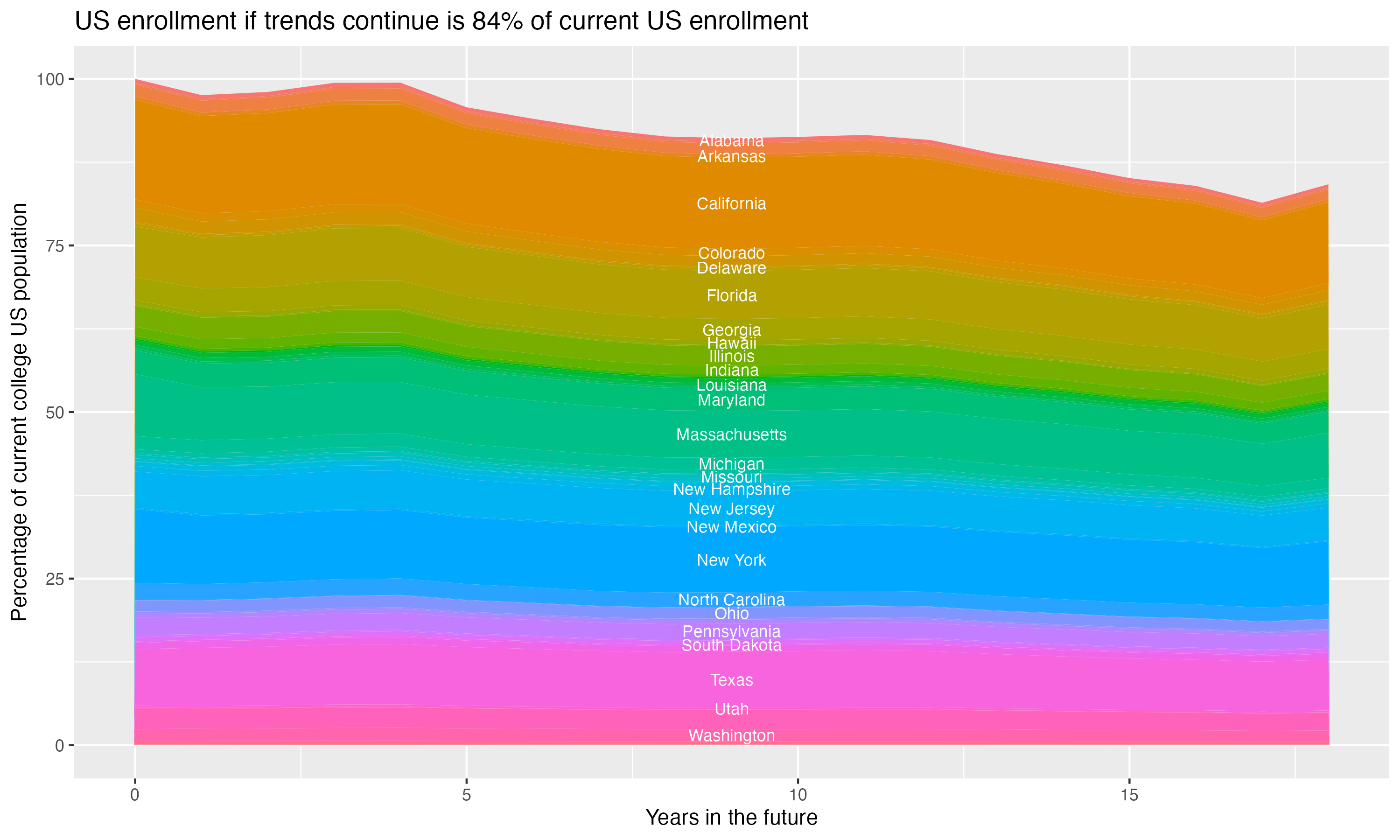Massachusetts Institute of Technology
Massachusetts Institute of Technology is located in Cambridge, Massachusetts. It is a private not-for-profit, 4-year or above institution.
From Wikipedia: The Massachusetts Institute of Technology (MIT) is a private research university in Cambridge, Massachusetts, United States. Established in 1861, MIT has played a significant role in the development of many areas of modern technology and science. In response to the increasing industrialization of the United States, William Barton Rogers organized a school in Boston to create “useful knowledge.” Initially funded by a federal land grant, the institute adopted a polytechnic model that stressed laboratory instruction in applied science and engineering. MIT moved from Boston to Cambridge in 1916 and grew rapidly through collaboration with private industry, military branches, and new federal basic research agencies, the formation of which was influenced by MIT faculty like Vannevar Bush. In the late twentieth century, MIT became a leading center for research in computer science, digital technology, artificial intelligence and big science initiatives like the Human Genome Project. Engineering remains its largest school, though MIT has also built programs in basic science, social sciences, business management, and humanities. The institute has an urban campus that extends more than a mile (1.6 km) along the Charles River. The campus is known for academic buildings interconnected by corridors and many significant modernist buildings. MIT’s off-campus operations include the MIT Lincoln Laboratory and the Haystack Observatory, as well as affiliated laboratories such as the Broad and Whitehead Institutes. The institute also has a strong entrepreneurial culture and MIT alumni have founded or co-founded many notable companies. As of October 2024, 105 Nobel laureates, 26 Turing Award winners, and 8 Fields Medalists have been affiliated with MIT as alumni, faculty members, or researchers. In addition, 58 National Medal of Science recipients, 29 National Medals of Technology and Innovation recipients, 50 MacArthur Fellows, 83 Marshall Scholars, 41 astronauts, 16 Chief Scientists of the US Air Force, and 8 foreign heads of state have been affiliated with MIT.
Overview of institution
This, and the rest of the page, use info from the most recent year available, generally 2024.
Institution kind: Doctoral Universities: Highest Research Activity
Undergrad program: Arts & sciences plus professions, high graduate coexistence
Graduate program: Research Doctoral: Comprehensive programs, no medical/veterinary school
Enrollment profile: Majority graduate (see more details below)
Average net price for undergrads on financial aid: $21,519 (1.2 times the equivalent cost of Harvard).
Actual price for your family: Go here to see what your family may be asked to pay. It can be MUCH lower than the average price but also higher for some.
Size and setting: Four-year, large, highly residential
In state percentage: 8.2% of first year students come from Massachusetts
In US percentage: 89% of first year students come from the US
Graduation rate (within 6 years) for students seeking a Bachelors: 96.1% (this is what is usually reported as “graduation rate”)
Graduation rate (within 4 years) for students seeking a Bachelors: 82.3%
Student to tenure-stream faculty ratio: 4.3 (undergrads to tenure-stream faculty) [Tenure explained]
Student to faculty ratio: 4.3 (undergrads to all faculty)
Degrees offered: Bachelor’s degree, Master’s degree, Doctor’s degree: research scholarship
Schedule: Four-one-four plan
Institution provides on campus housing: Yes
Dorm capacity: There are enough dorm beds for 8000 students
Freshmen required to live on campus: No
Advanced placement (AP) credits used: Yes
Disabilities: 7.50 percent of undergrads are registered as having disabilities.
Undergrad outcomes
This plot shows the outcomes for first time, full time undergraduates seeking Bachelor’s degrees (if the data are available).

Map
Comparisons
The sections below show this institution compared with others. The ones listed are ones it has identified as peers, who consider themselves peers, and/or who the federal government considers peers. If a comparison school has the same value as the focal school, its cell is grayed out. In fields where there is a common view that higher (or lower) values are better, the best values are in blue, the worst values are in red. If there isn’t a sense of a particular value being better, values are shown in varying shades of green. Arrows show where there is a signficant trend over time for a school. You can swipe across the table to see more of it; the focal school column is always visible.
- Massachusetts Institute of Technology lists these schools as ones to compare itself within federal IPEDS data, and they do the same back: Harvard University, Stanford University, Yale University, Cornell University, Carnegie Mellon University, California Institute of Technology
- Massachusetts Institute of Technology compares itself to these institutions, but not vice versa: Princeton University
- These institutions compare themselves to Massachusetts Institute of Technology, but not vice versa: University of Chicago, University of Pennsylvania, New York University, Northwestern University, Brown University, United States Naval Academy, Dartmouth College, University of Michigan-Ann Arbor, University of Notre Dame, Johns Hopkins University, Vanderbilt University, University of Southern California, Barnard College, Washington University in St Louis, University of Virginia-Main Campus, Georgia Institute of Technology-Main Campus, United States Air Force Academy, Rice University, Emory University, Bowdoin College, Wellesley College, Harvey Mudd College, The Cooper Union for the Advancement of Science and Art, Stevens Institute of Technology, Worcester Polytechnic Institute, Rensselaer Polytechnic Institute, Rochester Institute of Technology, Franklin W Olin College of Engineering, Embry-Riddle Aeronautical University-Daytona Beach, Illinois Institute of Technology, Rose-Hulman Institute of Technology, Missouri University of Science and Technology, Embry-Riddle Aeronautical University-Prescott, Florida Institute of Technology, Embry-Riddle Aeronautical University-Worldwide, University of Wisconsin-Stout, Lawrence Technological University, CUNY Graduate School and University Center, The Rockefeller University, University of Advancing Technology
Enrollment

General
Teaching
Tenure track faculty are those who are eligible for tenure. This includes both pre-tenure and tenured faculty. Once faculty get tenure, they are (generally) protected from being fired for intellectual reasons, helping to ensure their freedom in teaching and research. They can still lose their positions for misconduct, financial problems, not fulfilling their duties, or other reasons.
Non-tenure track faculty are not eligible for tenure. Some are hired one semester at a time, some have multi-year contracts. They typically have a higher teaching load than tenure track faculty, leaving less time for research or other creative endeavors. They are also easier to fire than tenured faculty. Sometimes they are external experts (a noted musician, a former senator) who are hired to teach some classes without the expected permanence of a tenure-track position.
Note that this chart uses US federal demographic data: it only has two genders and a specified set of ethnicities and races.
Having a low student to faculty ratio is considered a good thing by many, as it can mean more individual attention.
Geography
This has information on the location of the institution. See the about page for more information on what the metrics are and how they are calculated.
Financial Aid
Graduation
Note these are bachelors graduation rates in six years, not four (this is standard). Sample sizes can be small for some demographic groups with few individuals in a school, leading to large year-to-year fluctuations and often extreme values for those groups (if there are two individuals in the class with a given identity, the possible graduation rates are 0%, 50%, or 100% depending on whether zero, one, or both students graduate within six years).
Library
Libraries are changing rapidly. Note that how institutions count digital collections may vary.
Diversity
The US Census Bureau has a diversity index that goes from 0 to 1. In their words, “A 0-value indicates that everyone in the population has the same racial and ethnic characteristics. A value close to 1 indicates that everyone in the population has different racial and ethnic characteristics.” This uses their formula, but with the resolution available for the federal IPEDS data (which does not separate for a given demographic group whether members identify as Hispanic or not). This metric is about heterogeneity within the population, not the proportion of the population that comes from historically excluded groups.
Following the practice of the census, the index is multiplied by 100 to give the percentage probability a random pair of individuals will have a different background. Most institutions argue that diversity is a benefit, so by default a higher number is listed as better, but there may be cases where this measure does not reflect the mission of a college (for example, 70% of the students at a tribal college or university may be American Indian: that could be low-scoring by this metric but should not be read as “bad” given the institution’s mission).
These numbers are based on the most recent year available, generally 2024, which predates effects of the US Supreme Court’s striking down of affirmative action. This has often changed, sometimes dramatically, the incoming student demographics at some institutions.
Overall diversity
Freshman profile
Demographic data for first time degree-seeking students. Note that this uses US federal demographic data: it only has two genders and a specified set of ethnicities and races.
Freshman geography
Test scores
SAT scores
ACT scores
Majors
This presents information on the number of majors and the median earnings one and five years after graduation for people who got a degree from this institution in that field. The earnings are for those who are working and not enrolled in further education. The earnings data (from the federal college scorecard) also has information on earnings for those categorized as ‘MALE’ and ‘NOMALE’ – for readability, these are recategorized here as “Men” and “Women”, respectively, which adopts the gender binary used in other federal data. “W/M earnings ratio” is the median earnings of women divided by men, as a percentage.
Bachelors
Masters
Doctorate
Certificate
Associates
Demographic cliff
There is a concern that giving changing US demographics, the number of students in the age groups who most commonly attend four year colleges will drop off, decreasing overall enrollment. This is often referred to as the “demographic cliff”, and it can be a concern for colleges concerned about the risk of falling enrollment. For this section, the analysis uses US census data on the number of people in each state by age, and the proportion of students that come from each state for this particular college, to crudely model what will happen if everything remains constant except the demographic change in the population of 18 year olds in each year – it does not account for things like the college increasing its admission rate, attracting more students from states without the same demographic changes or from other countries, or changes in the proportion of students who go to college.
